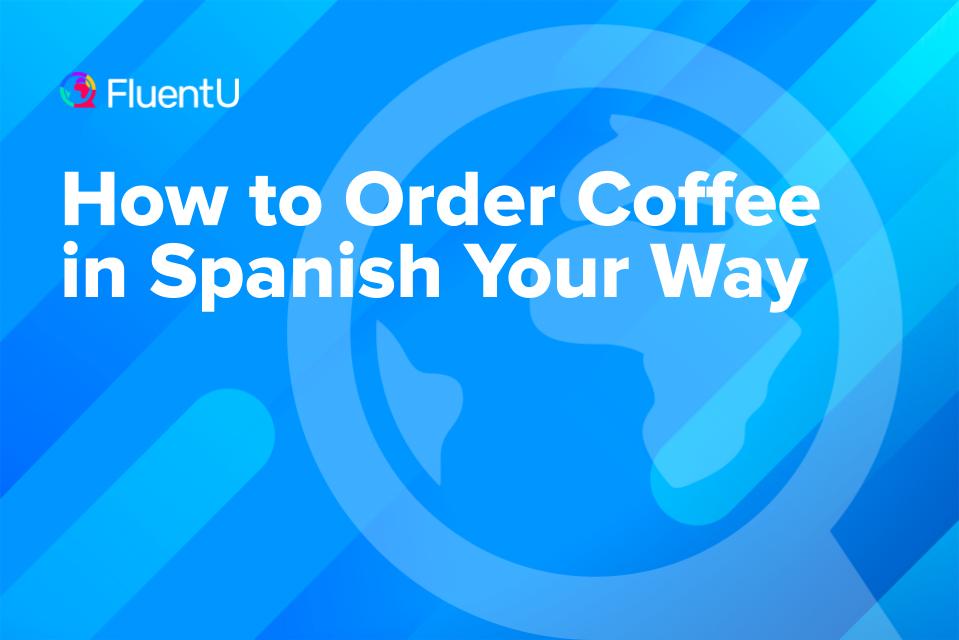How to Order Coffee in Spanish Your Way

If you’re a coffee lover visiting a Spanish-speaking country, knowing how to order your cup of joe is a must. We’re here to save you from a pre-caffeine panic when the barista asks you “¿En que le puedo ayudar?” (How can I help you?)
In this post, you’ll learn everything you need to know to order your favorite coffee drink. We’ll go over how to place an order, the different types of coffee drinks and the many types of milks and other additives you can add to your cup.
Download: This blog post is available as a convenient and portable PDF that you can take anywhere. Click here to get a copy. (Download)
Phrases for Ordering Coffee in Spanish
A common mistake Spanish learners often make is using the phrase “Puedo tener…?” to order something at a café or restaurant, similar to how we say “Can I have…?” in English. This, however, is incorrect.
You can use these phrases instead:
| Spanish | English |
|---|---|
| Un café, por favor. | A coffee, please. |
| ¿Me da un café, por favor?
¿Me das un café, por favor? | Can you give me a coffee, please? (formal, informal) |
| Quisiera un café, por favor. / Me gustaría un café, por favor. | I'd like a coffee, please. |
| Tráigame un café, por favor.
Tráeme un café, por favor. | Bring me a coffee, please. (formal, informal) |
| ¿Me traería un café?
¿Me traerías un café? | Would you bring me a coffee? (formal, informal) |
| Voy a pedir un café con leche. | I'm going to order a coffee with milk. |
| Para mí...un café con leche. | For me...a coffee with milk. |
| ¿Sería tan amable de traerme un café?
¿Serías tan amable de traerme un café? | Would you be so kind as to bring me a coffee? (formal, informal) |
You may have experienced that moment of panic when the server or barista approaches you and you haven’t decided on your order yet. In those situations, you can use one of these phrases:
| Spanish | English |
|---|---|
| Un momento, por favor. | Just a minute, please. |
| Todavía estoy viendo. | I’m still looking. |
| No he decidido aún. | I haven't decided yet. |
How to Address the Staff at a Restaurant or Café
You may have noticed that we provided the formal and informal versions of a few of the phrases above. So should you use tú or usted with a server, barista or other staff at a restaurant or café?
In Spain, it’s very common to use the informal tú form with restaurant staff. It isn’t considered rude as long as you treat them with respect.
In Latin America, it’s also common for people to address restaurant staff as tú, although older people will often use usted and you’ll definitely hear this formal address more often than in Spain. If you want to be extra careful, you can use the usted form, especially if the person is older than you.
However, again, it’s not considered rude to treat restaurant staff informally with the tú form, as long as you’re kind and polite.
Essential Vocabulary for Placing Your Order
How best to order exactly what you want? Learn your coffee lingo! With so many choices, it’s not hard to mix things up, so let’s go over the basics.
Types of Coffee Drinks
| Spanish | English | Description |
|---|---|---|
| café solo | "only coffee" | Popular in Spain, this is a single shot of espresso served in a small cup. |
| café negro | black cofee | Like in English, this is just plain coffee with no milk, cream or sweetener. |
| café doble | double coffee | This one is also exactly what the name implies: two shots of espresso. |
| café americano | American coffee | This is typically espresso diluted with water. |
| cortado | "cut coffee" | This is espresso “cut” with a bit of milk. |
| café con leche | coffee with milk | This usually comes with about half espresso (or coffee) and half milk. |
| café con leche y canela | coffee with milk and cinnamon | In Mexico, coffee with cinnamon is called "café de olla." |
| café con hielo / café del tiempo | coffee with ice | Unless you're in a more modern coffee shop, you might just get some coffee and a cup of ice if you order this! |
| cafe descafeinado | decaf coffee | This won't be available everywhere, but if you want the coffee taste without the caffeine rush, now you can ask for it. |
| café instantáneo
/ café soluble | instant coffee | This is popular in much of Latin America. You can ask “¿El café es instantáneo o en grano?” (“Is the coffee instant or whole bean?”). |
| café de tueste ligero
de tueste medio de tueste oscuro | light roast coffee medium roast dark roast | If you're somewhere in Latin America that offers these options, you're probably in for a great cup of coffee. |
If you’re buying coffee beans at a coffee shop, they’ll probably ask you if you want it en grano o molido (whole bean or ground).
Another way to say coffee in beans (not instant) is café para pasar , which literally translates to “coffee to pass” and means it will pass through the coffee or espresso machine. You can ask for this at a grocery store, for example.
If you want to learn more about coffee terms in Spanish, check out this video podcast:
Types of Milk
Nowadays, there are a plethora of milk options available. Don’t expect to have these options at most small coffee shops or restaurants in Latin America, but if you’re in a big city or a particularly touristy area, these terms may come in handy:
| Spanish | English |
|---|---|
| leche entera | whole milk |
| leche semidesnatada | reduced fat milk |
| leche desnatada | skim milk |
| leche condensada | condensed milk |
| leche de vaca | cow’s milk |
| leche de cabra | goat’s milk |
| leche de soya | soy milk |
| leche de almendra | almond milk |
| leche de avellana | hazelnut milk |
| leche de anacardo | cashew milk |
| leche de avena | oat milk |
| leche de coco | coconut milk |
| leche vaporizada | steamed milk |
| espuma | foam |
| leche caliente | hot milk |
| leche tibia | warm milk |
Again, not all types will be available everywhere, but it never hurts to ask—and practice your Spanish!
Coffee Additives
Looking for something to mix into that café other than leche? Here are some common options:
| Spanish | English |
|---|---|
| azúcar | sugar |
| miel | honey |
| estevia | stevia |
| edulcorante | sweetener |
| crema | cream |
| crema batida | whipped cream |
| jarabes saborizados (vainilla, caramelo, etc.) | flavored syrups (vanilla, caramel, etc.) |
| canela | cinnamon |
| cacao en polvo | cocoa powder |
| nuez moscada | nutmeg |
Like with the different types of milk, these options won’t be available everywhere you go. But now you can ask for them or recognize them on a menu!
Other Helpful Coffee-Related Vocabulary
If you’re a true coffee fan, you might need to know some of these useful terms related to ordering, drinking and preparing coffee:
| Spanish | English |
|---|---|
| una cafetería | a café |
| una taza | a mug |
| un vaso | a glass |
| un termo | a thermos |
| para llevar | to go/to take away |
| para servir | for here |
| una cafetera | a coffee maker |
| un filtro de café | a coffee filter |
| un molinillo de café | a coffee grinder |
| una cafetera de émbolo / prensa francesa | a French press |
| una máquina de espresso | an espresso machine |
| granos de café | coffee beans |
| aromático / aromática | aromatic |
| el tueste de café | the coffee roast |
| molido fino | fine ground |
| molido grueso | course ground |
| una cucharilla | a teaspoon |
| una cucharada | a scoop/tablespoon |
| empaque al vacío | vaccuum-sealed |
Regional Varieties of Coffee Drinks
Coffee is produced in so many Spanish-speaking countries it’s not surprising that they have a couple of special brews up their sleeves.
If you’re in Spain and want a coffee with a kick of alcohol, order un carajillo. This is espresso served with rum, whisky or brandy. If you’re in Chile around Christmas time, order a cola de mono or Colemono , usually made with aguardiente (a type of liquor), milk, sugar, coffee and cloves.
If you’ve got a sweet tooth, order a café bombón. Originating in Valencia, Spain, it’s made by layering espresso with condensed milk and is typically served in a glass cup.
If you’re in Cuba (or Miami), you can satisfy your sweet tooth with a café cubano, which is made by pouring a hot shot of espresso over sugar and then stirring them together. Or you can make your own at home:
Coffee Culture in Spanish-speaking Countries
Spanish-speaking countries are known for having a culture where tomar un café (to have a coffee) is a common expression and is done throughout the day, including after dinner.
Coffee drinking in Spanish-speaking countries is a social event, a time for chatting with friends, family and colleagues. It’s something to be enjoyed and savored. Even early in the day, most who stop for a morning cup don’t rush out of the café.
That’s why you probably won’t see to-go cups in various sizes on display in most coffee shops in Spanish-speaking countries. If you order a café solo, you’ll probably get it in a very small cup—sometimes almost like a shot glass. Otherwise, your coffee drink will likely come in a mug.
If you can, try to do like the locals do and take some time to enjoy it, rather than rushing off to your next activity.
And for more practice, watch native speakers order at restaurants and cafés with an immersive language learning program like FluentU.
FluentU takes authentic videos—like music videos, movie trailers, news and inspiring talks—and turns them into personalized language learning lessons.
You can try FluentU for free for 2 weeks. Check out the website or download the iOS app or Android app.
P.S. Click here to take advantage of our current sale! (Expires at the end of this month)

Now you know how to order coffee in Spanish, in pretty much every way possible.
Review and practice these words and phrases so the next time you’re in a Spanish-speaking country, you can confidently get your coffee fix!
Download: This blog post is available as a convenient and portable PDF that you can take anywhere. Click here to get a copy. (Download)
And One More Thing…
If you've made it this far that means you probably enjoy learning Spanish with engaging material and will then love FluentU.
Other sites use scripted content. FluentU uses a natural approach that helps you ease into the Spanish language and culture over time. You’ll learn Spanish as it’s actually spoken by real people.
FluentU has a wide variety of videos, as you can see here:

FluentU brings native videos within reach with interactive transcripts. You can tap on any word to look it up instantly. Every definition has examples that have been written to help you understand how the word is used. If you see an interesting word you don’t know, you can add it to a vocab list.

Review a complete interactive transcript under the Dialogue tab, and find words and phrases listed under Vocab.

Learn all the vocabulary in any video with FluentU’s robust learning engine. Swipe left or right to see more examples of the word you’re on.

The best part is that FluentU keeps track of the vocabulary that you’re learning, and gives you extra practice with difficult words. It'll even remind you when it’s time to review what you’ve learned. Every learner has a truly personalized experience, even if they’re learning with the same video.
Start using the FluentU website on your computer or tablet or, better yet, download the FluentU app from the iTunes or Google Play store. Click here to take advantage of our current sale! (Expires at the end of this month.)







